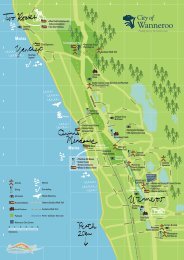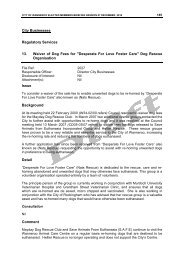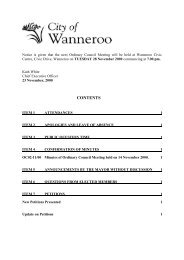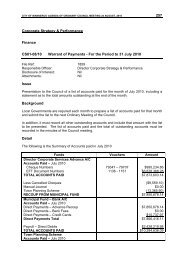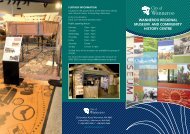EGlINTON - City of Wanneroo
EGlINTON - City of Wanneroo
EGlINTON - City of Wanneroo
You also want an ePaper? Increase the reach of your titles
YUMPU automatically turns print PDFs into web optimized ePapers that Google loves.
1.3 Background and Context<br />
1.3.1 Sustainability in Urban Development<br />
Human settlements have a large impact on the earth’s ecosystems. Urban development and buildings in<br />
particular contribute significantly to the negative impact we are having on our environment. It has been<br />
estimated that buildings consume 32% <strong>of</strong> the world’s resources including 12% <strong>of</strong> the world’s water and<br />
up to 40% <strong>of</strong> the world’s energy. Buildings also produce 40% <strong>of</strong> waste going to landfill and 40% <strong>of</strong> air<br />
emissions.<br />
At a time when climate change is already affecting Western Australia, when water quantity and quality is<br />
in decline and when animal and plant extinctions in Australia are occurring at an unprecedented rate, the<br />
advancement <strong>of</strong> Sustainability is not an option but all <strong>of</strong> our responsibility.<br />
Ecologically Sustainable Development therefore, represents one <strong>of</strong> the biggest challenges facing<br />
Australia’s governments, industry, business and the community at large. In Perth and Peel this is<br />
particularly so as it faces an unprecedented rate <strong>of</strong> economic growth and a projected population increase<br />
to 2.2 million by 2031. With about 90% <strong>of</strong> the Western Australian population living in towns and cities, the<br />
quality <strong>of</strong> the urban environment is important in relation to our wellbeing. The movement towards<br />
sustainable communities takes recognition <strong>of</strong> the need for environmentally sustainable forms <strong>of</strong><br />
development a step further towards the need to ensure that a community is socially sustainable. A<br />
sustainable community, also described as a “healthy” or “liveable” community, maximises quality <strong>of</strong> life<br />
for its residents and is more environmentally and economically sustainable.<br />
The key to achieving a sustainable community is to address issues in an interconnected manner and<br />
ensure that all the key dimensions <strong>of</strong> the planning process are strongly integrated throughout the<br />
process. This integration involves the development <strong>of</strong> an urban form strongly informed by the following<br />
issues:<br />
� Environmental protection (or remediation);<br />
� Land use planning that takes account <strong>of</strong> demographic trends, living, employment and leisure<br />
needs;<br />
� Transport and access requirements;<br />
� Energy and water efficiency objectives;<br />
� Market and development trends; and<br />
� Regional planning objectives.<br />
1.3.2 Sustainability and District Structure Planning<br />
In 2006, GHD prepared the Sustainability Strategy to support the Alkimos Eglinton DSP. The strategy<br />
outlined the sustainability objectives and key priorities applicable to the residential land development<br />
project, building upon the Smart Growth Assessment Tool (SGAT, see Section 1.3.3) and the State<br />
Sustainability Strategy (see Section 1.3.4).<br />
61/25198/98570<br />
Eglinton Local Structure Plan<br />
Sustainability Strategy<br />
1



